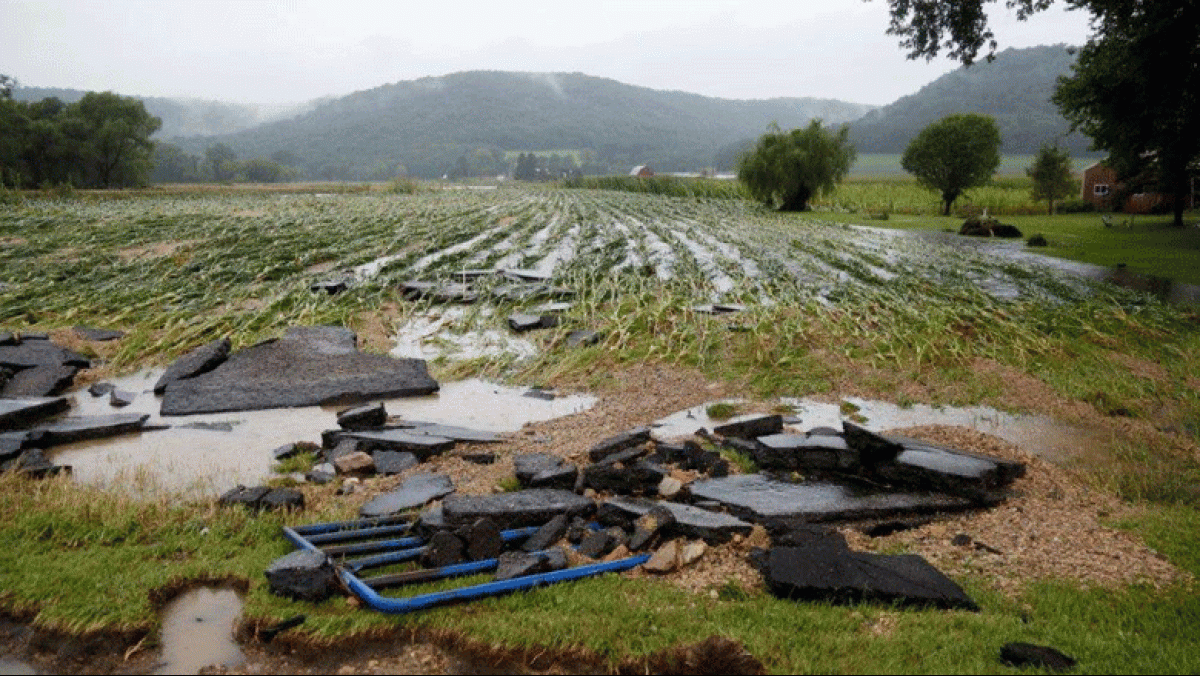People often recount the floods in living memory. As a child, I heard about the Kickapoo River flood of 1978, after which Soldiers Grove—the town just north of where I grew up—moved to higher ground; homes, businesses, and about 600 people were relocated off of the floodplain. There were the successive, record-breaking floods of 2007 and 2008, after which Gays Mills (south of us) moved to higher ground and a number of houses on the edge of that floodplain were raised by 18 inches. The 2016 flash flood of Tainter Creek washed my own mother’s car off the road—with her in it. Thankfully, she was rescued from the rising waters by the village fire chief after being stranded in her car for a few terrifying hours.
August 2018 will be remembered for record-breaking floods that brought devastation throughout the Driftless Area. In Gays Mills, where flood stage for the Kickapoo River is 13 feet, floodwaters reached over 22 feet, inundating most of the houses that had been raised after the 2008 floods. In Coon Valley, a small town in Vernon County, the catastrophe surpassed anything in memory. Fortunately, no one died in the floods here. But in Vernon County alone, over 350 people had to be rescued from floodwaters, and official estimates tallied more than $108 million in residential storm damage and $75 million in public infrastructure damage.
Water has been wearing away at Wisconsin forever. While earthbound glaciers shaped much of the state, it was water from the sky that cut the iconic valleys into the bedrock of the Driftless. Over millions of years, the rich soils and lush vegetation that slowly developed to blanket these hills and valleys did a good job of absorbing the rain, which filtered down through layers of ancient limestone and emerged as natural springs that fed picturesque streams and rivers. Twelve thousand years of indigenous land use maintained this pattern.
Then something changed. As the world became more populated, and agriculture became more intensive, farmers came to the Driftless in search of fertile soil. It took only a few generations of woodland cutting, hard farming, and overgrazing before the blanket of soil, sod, and forest had been worn threadbare. By the 1920s, landslides and floods were swallowing farm fields and houses alike; whole Driftless communities teetered on the edge of extinction.
By 1933, Coon Valley farmers had had enough. They banded together with local, state, and federal representatives, and the Civilian Conservation Corps, for the first large-scale watershed demonstration of the newly formed Soil Erosion Service (today the USDA’s Natural Resource Conservation Service). The farmers adopted new methods of managing their land—contour rows, crop rotations, grain crops interspersed with perennial pasture, farm ponds, riparian buffers, restored hillside woodlands—to retain their soil and improve its capacity to infiltrate, which helped to prevent erosion and restore the health of local waterways. Not only did these changes help save their farmland and their town, but Coon Creek became one of many Driftless streams that went from being effectively dead during the Dust Bowl years to a world-class trout stream today.
People still look to Coon Valley farmers as leaders in conservation. In August of 2018, I visited Rod Ofte, who farms with his family just outside of town, to hold a workshop that attracted farmers from all over the Midwest who wanted to learn about his innovative methods of holding on to soil. Ofte, like his Coon Valley forebears, knows that healthy soil can buffer against floods. He also knows that healthy soil holds more carbon, and the more carbon we have underground the less carbon dioxide there is the atmosphere to fuel climate change. Yet all this knowledge in practice didn’t stop the devastating floodwaters that came rushing onto his farm just a few weeks after our workshop.
Looking at the floods within our collective memory, and what these floods are doing to our communities in the Driftless, we see that the imperative is increasingly clear: we need to deal with our changing climate. The good news is that we can do more than retreat to higher ground. As stewards of photosynthesis, farmers have the power to pull carbon out the atmosphere. With support from consumers, policy-makers, and each other, farmers can better manage their soils to hold on to more carbon and, subsequently, hold more water. The growing interest among farmers of all types in this concept of soil health may hinge primarily on their hope for more healthy crops. But healthy soils also benefit the health of our watersheds and climate.
Ofte and Driftless farmers like him are already at work on this. Well-managed pastures on grass-fed beef and organic farms help to build soils, even though this kind of agriculture faces pressures from forces that favor larger farms and confined livestock operations. Tainter Creek now has a farmer-led watershed council organized around preserving water quality, and a growing number of such groups are forming across Wisconsin.
In the Dust Bowl Era, Coon Valley residents rose to the occasion to find solutions to the climate crisis of their time. Those solutions, first adopted by farmers here and eventually throughout much of Wisconsin, were sufficient to handle the water that fell during 20th-century storms and help address their flooding problem. As climate change accelerates, however, the storms of the 21st century are proving more frequent and intense. For our generation, for our communities, the question is not if we will see another flood, but when it will come, and how we might ready ourselves.














